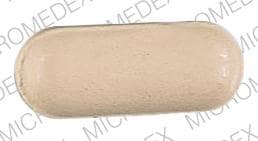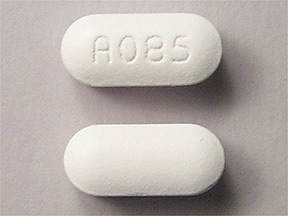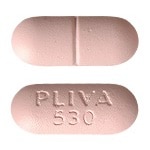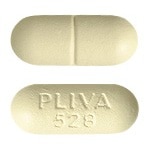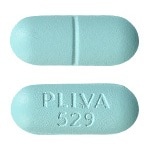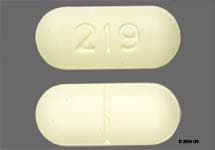Dosage Forms
Excipient information presented when available (limited, particularly for generics); consult specific product labeling.
Liquid, Oral:
Generic: 500 mg/5 mL (240 mL)
Pharmacology
Mechanism of Action
Weakly inhibits cyclooxygenase enzymes, which results in decreased formation of prostaglandin precursors; antipyretic, analgesic, and anti-inflammatory properties.
Other proposed mechanisms not fully elucidated (and possibly contributing to the anti-inflammatory effect to varying degrees) include inhibiting chemotaxis, altering lymphocyte activity, inhibiting neutrophil aggregation/activation, and decreasing proinflammatory cytokine levels.
Pharmacokinetics/Pharmacodynamics
Absorption
Liquid: Rapid from stomach and small intestine
Distribution
Readily distributes into most body fluids and tissues
Metabolism
Conjugated to glycine and glucuronide metabolites; the glycine conjugation pathway is rapidly saturated at higher doses.
Excretion
Urine (major route; primarily as metabolites; 10% excreted as unchanged drug); bile (minor route)
Time to Peak
Serum: Liquid: 1 to 2 hours
Half-Life Elimination
Dose dependent: Tablet: 9 to 17 hours
Protein Binding
90% to 95%
Use: Labeled Indications
Acute painful shoulder: Management of acute painful shoulder
Analgesia: Relief of mild to moderate pain
Antipyresis: Management of pyrexia
Arthritis: Relief of signs/symptoms of osteoarthritis, rheumatoid arthritis, and other arthritis (long-term management and acute flares)
Juvenile idiopathic arthritis: Anti-inflammatory or analgesic management (in children) of juvenile idiopathic arthritis and other appropriate conditions
Contraindications
Hypersensitivity to choline magnesium trisalicylate, other nonacetylated salicylates, or any component of the formulation
Dosage and Administration
Dosing: Adult
Note: Dosing is based on salicylate content. Individualize dose based on response; may require 2 to 3 weeks to achieve optimal effect.
Acute painful shoulder, osteoarthritis, rheumatoid arthritis, or other severe arthritis: Oral: Initial: 1.5 g twice daily or 3 g once daily at bedtime
Analgesia (mild to moderate pain) or pyrexia: Oral: 2 to 3 g daily in 2 or 3 divided doses; adjust dose to obtain optimal therapeutic response.
Dosing: Geriatric
Usual dose: 750 mg 3 times daily; adjust dose to obtain optimum therapeutic response.
Dosing: Pediatric
Note: Dosing is based on total salicylate content. Individualize dose based on response; may require 2 to 3 weeks to achieve optimal effect.
Inflammatory conditions (eg, juvenile idiopathic arthritis) and analgesia (mild to moderate pain): Children and Adolescents:
Manufacturer's labeling:
Weight-directed dosing: Patient weight ≤37 kg: Oral: 25 mg/kg/dose twice daily
Fixed-dosing (weight-band):
12 to 13 kg: 250 mg twice daily
14 to 17 kg: 375 mg twice daily
18 to 22 kg: 500 mg twice daily
23 to 27 kg: 625 mg twice daily
28 to 32 kg: 750 mg twice daily
33 to 37 kg: 875 mg twice daily
>37 kg: Oral: 1,125 mg twice daily
Alternate dosing: Limited data available (Kliegman 2016): Oral: 10 to 20 mg/kg/dose every 8 to 12 hours
Administration
Oral: Administer with food or large volume of water or milk to minimize GI upset. Liquid may be mixed with fruit juice just before drinking.
Storage
Store between 15°C and 30°C (59°F and 86°F).
Choline Magnesium Trisalicylate Images
Drug Interactions
Agents with Antiplatelet Properties (e.g., P2Y12 inhibitors, NSAIDs, SSRIs, etc.): May enhance the adverse/toxic effect of Salicylates. Increased risk of bleeding may result. Monitor therapy
Ajmaline: Salicylates may enhance the adverse/toxic effect of Ajmaline. Specifically, the risk for cholestasis may be increased. Monitor therapy
Ammonium Chloride: May increase the serum concentration of Salicylates. Monitor therapy
Angiotensin-Converting Enzyme Inhibitors: Salicylates may enhance the nephrotoxic effect of Angiotensin-Converting Enzyme Inhibitors. Salicylates may diminish the therapeutic effect of Angiotensin-Converting Enzyme Inhibitors. Monitor therapy
Anticoagulants: Salicylates may enhance the anticoagulant effect of Anticoagulants. Monitor therapy
Benzbromarone: Salicylates may diminish the therapeutic effect of Benzbromarone. Monitor therapy
Blood Glucose Lowering Agents: Salicylates may enhance the hypoglycemic effect of Blood Glucose Lowering Agents. Monitor therapy
Carbonic Anhydrase Inhibitors: Salicylates may enhance the adverse/toxic effect of Carbonic Anhydrase Inhibitors. Salicylate toxicity might be enhanced by this same combination. Management: Avoid these combinations when possible.Dichlorphenamide use with high-dose aspirin as contraindicated. If another combination is used, monitor patients closely for adverse effects. Tachypnea, anorexia, lethargy, and coma have been reported. Exceptions: Brinzolamide; Dorzolamide. Consider therapy modification
Corticosteroids (Systemic): Salicylates may enhance the adverse/toxic effect of Corticosteroids (Systemic). These specifically include gastrointestinal ulceration and bleeding. Corticosteroids (Systemic) may decrease the serum concentration of Salicylates. Withdrawal of corticosteroids may result in salicylate toxicity. Monitor therapy
Ginkgo Biloba: May enhance the anticoagulant effect of Salicylates. Management: Consider alternatives to this combination of agents. Monitor for signs and symptoms of bleeding (especially intracranial bleeding) if salicylates are used in combination with ginkgo biloba. Consider therapy modification
Herbs (Anticoagulant/Antiplatelet Properties) (eg, Alfalfa, Anise, Bilberry): May enhance the adverse/toxic effect of Salicylates. Bleeding may occur. Consider therapy modification
Hyaluronidase: Salicylates may diminish the therapeutic effect of Hyaluronidase. Management: Patients receiving salicylates (particularly at larger doses) may not experience the desired clinical response to standard doses of hyaluronidase. Larger doses of hyaluronidase may be required. Consider therapy modification
Influenza Virus Vaccine (Live/Attenuated): May enhance the adverse/toxic effect of Salicylates. Specifically, Reye's syndrome may develop. Avoid combination
Loop Diuretics: Salicylates may diminish the diuretic effect of Loop Diuretics. Loop Diuretics may increase the serum concentration of Salicylates. Monitor therapy
Methotrexate: Salicylates may increase the serum concentration of Methotrexate. Salicylate doses used for prophylaxis of cardiovascular events are not likely to be of concern. Consider therapy modification
Potassium Phosphate: May increase the serum concentration of Salicylates. Monitor therapy
PRALAtrexate: Salicylates may increase the serum concentration of PRALAtrexate. Salicylate doses used for prophylaxis of cardiovascular events are unlikely to be of concern. Consider therapy modification
Probenecid: Salicylates may diminish the therapeutic effect of Probenecid. Monitor therapy
Salicylates: May enhance the anticoagulant effect of other Salicylates. Monitor therapy
Sulfinpyrazone: Salicylates may decrease the serum concentration of Sulfinpyrazone. Avoid combination
Thrombolytic Agents: Salicylates may enhance the adverse/toxic effect of Thrombolytic Agents. An increased risk of bleeding may occur. Monitor therapy
Valproate Products: Salicylates may increase the serum concentration of Valproate Products. Monitor therapy
Varicella Virus-Containing Vaccines: Salicylates may enhance the adverse/toxic effect of Varicella Virus-Containing Vaccines. Specifically, the risk for Reye's syndrome may increase. Avoid combination
Vitamin K Antagonists (eg, warfarin): Salicylates may enhance the anticoagulant effect of Vitamin K Antagonists. Consider therapy modification
Test Interactions
False-negative results for glucose oxidase urinary glucose tests (Clinistix®); false-positives using the cupric sulfate method (Clinitest®); also, interferes with Gerhardt test (urinary ketone analysis), VMA determination; 5-HIAA, xylose tolerance test, and T3 and T4; increased PBI
Adverse Reactions
Frequency not defined.
<20%:
Gastrointestinal: Constipation, diarrhea, dyspepsia, epigastric pain, heartburn, nausea, vomiting
Otic: Tinnitus
<2%:
Central nervous system: Dizziness, drowsiness, headache, lethargy
Otic: Auditory impairment
<1%, postmarketing, and/or case reports: Anorexia, asthma, bruise, confusion, duodenal ulcer, dysgeusia, edema, epistaxis, erythema multiforme, esophagitis, gastric ulcer, hallucination, hearing loss (irreversible), increased blood urea nitrogen, increased liver enzymes, increased serum creatinine, occult blood in stools, pruritus, skin rash, weight gain
Warnings/Precautions
Concerns related to adverse effects:
- Gastrointestinal (GI) adverse effects: Nausea, vomiting, gastric upset, indigestion, heartburn, diarrhea, constipation, and/or epigastric pain may occur frequently.
- Tinnitus: Tinnitus is a common adverse effect; may indicate toxicity; reduce dose until tinnitus resolves.
Disease-related concerns:
- Asthma: Use with caution in patients with asthma. Non-acetylated salicylate products are associated with cross reactivity in aspirin-sensitive patients, although choline magnesium trisalicylate has been demonstrated to be well tolerated (with respect to respiratory symptoms) in patients with aspirin-sensitive asthma.
- Gastrointestinal disease: Use with caution in patients with gastritis or peptic ulcer disease. Avoid coadministration with ethanol; may enhance GI adverse effects, including GI bleeding.
- Hepatic impairment: Use with caution in patients with acute or chronic hepatic impairment.
- Renal impairment: Use with caution in patients with acute or chronic renal impairment.
Concurrent drug therapy issues:
- Drug-drug interactions: Potentially significant interactions may exist, requiring dose or frequency adjustment, additional monitoring, and/or selection of alternative therapy. Consult drug interactions database for more detailed information.
Special populations:
- Elderly: Use lowest effective dose for shortest period possible in the elderly; they are a high-risk population for adverse effects from salicylates/NSAIDs. Tinnitus may be a difficult and unreliable indication of toxicity due to age-related hearing loss or eighth cranial nerve damage.
- Pediatric: Children and teenagers who have or are recovering from chickenpox, influenza, or flu-like symptoms should not use salicylate products, including choline magnesium trisalicylate. Changes in behavior (along with nausea and vomiting) may be an early sign of Reye's syndrome; patients should be instructed to contact their healthcare provider if these occur.
Monitoring Parameters
Serum salicylate levels, renal function, hearing changes or tinnitus, abnormal bruising, and response (ie, pain)
Pregnancy
Pregnancy Risk Factor
C
Pregnancy Considerations
Animal reproduction studies have not been conducted. Due to the known effects of other salicylates on the fetal cardiovascular system (closure of ductus arteriosus), use during late pregnancy should be avoided.
Patient Education
What is this drug used for?
- It is used to ease pain and fever.
- It is used to treat arthritis.
Frequently reported side effects of this drug
- Abdominal pain
- Heartburn
- Nausea
- Vomiting
- Constipation
- Diarrhea
Other side effects of this drug: Talk with your doctor right away if you have any of these signs of:
- Noise or ringing in the ears
- Hearing loss
- Signs of a significant reaction like wheezing; chest tightness; fever; itching; bad cough; blue skin color; seizures; or swelling of face, lips, tongue, or throat.
Note: This is not a comprehensive list of all side effects. Talk to your doctor if you have questions.
Consumer Information Use and Disclaimer: This information should not be used to decide whether or not to take this medicine or any other medicine. Only the healthcare provider has the knowledge and training to decide which medicines are right for a specific patient. This information does not endorse any medicine as safe, effective, or approved for treating any patient or health condition. This is only a brief summary of general information about this medicine. It does NOT include all information about the possible uses, directions, warnings, precautions, interactions, adverse effects, or risks that may apply to this medicine. This information is not specific medical advice and does not replace information you receive from the healthcare provider. You must talk with the healthcare provider for complete information about the risks and benefits of using this medicine.
